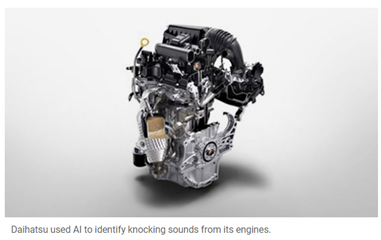This post is from guest blogger Paul Pilotte, Product Marketing, AI and Data Science and David Willingham, Product Marketing, Deep Learning
The world has changed significantly since we tracked the
AI Trends for 2021 a year ago. While some industries have cut back on AI investment in the near term, others have increased their investment above what they had forecasted, offsetting the loss. Many are using this time to invest in upskilling through remote learning, with AI-themed courses among the most sought after by the engineering and scientific community. The goal is to make sure they are primed and ready to take on more AI projects in 2022.
Here's a closer look at 4 current trends within AI.
|
1
|
Collaboration between frameworks |
New trend materializing for 2022
TensorFlow, PyTorch, and MATLAB are three different deep learning frameworks which you can use to develop AI models. When developing a larger system that includes AI, engineering teams can be faced with the question: which framework to use? Choosing one becomes complicated, especially if no single framework can satisfy all the requirements of the system being developed: an engineering team may want to use a data preprocessing app in MATLAB as well as reuse a pretrained AI model created in TensorFlow. The solution to meeting these requirements is to have the frameworks interoperate with each other.
| Prior to 2021, interoperating was quite complicated, and often involved some level of time-intensive manual recoding. However, 2021 saw the maturation of interoperability advancements such as a direct TensorFlow Converter for MATLAB, which has reduced the need for manual recoding, opening up more interoperability workflows. In 2022, we predict more collaboration between TensorFlow, PyTorch and MATLAB, through the understanding, adoption and expanding support of interoperability functionality. |
 |
|
2
|
AI aligns Engineering and IT |
A 2021 prediction, continuing in 2022 and beyond
The need to get value from AI models by getting them into production was a dominant theme in 2021. This proved not only the potential of AI models, but also the realization that the value of an AI Model is in production as part of an engineered system. Nearly every analyst in this space echoed this imperative. 2021 also marked the year of a growing trend to incorporate DevOps to AI models so that IT and OT teams can take ownership of the deployment, monitoring, and lifecycle of AI models in operational systems. We expect this trend to continue to accelerate in 2022, fueled by many corporate digital transformation initiatives. If you're not already involved in close collaboration between R&D teams developing AI models and production teams responsible for operational systems, you likely will be in 2022.
See an example of this trend:
Korea Institute of Energy Research Develops AI-Based Predictive Maintenance Models for Offshore Wind Power
A trend that materialized in 2021; we expect this trend to continue in 2022 and beyond
As the benefits of applying AI is becoming increasingly realized, many of the common techniques and workflows are being commoditized by vendors through no-code, low-code and auto-code workflows for AI modeling. The benefits of this are vast, first it broadens the community of AI users from a few data science and coding experts to a larger audience of people who have the domain knowledge to know where to apply AI, but not necessarily the coding skill set. Secondly it increases efficiency and scale through automated workflows.
Like the data-centric AI movement, no-code/low-code/auto-code is not a new trend. For example, for over 20 years engineers have been using MATLAB and Simulink to auto-generate or auto-code, production quality code for embedded systems.
Here are highlights of the use of no-code/low-code, auto-code by engineers using MATLAB and Simulink:
- No-code – Mitsui Chemicals created and deployed a no-code application for automated visual inspection of sheet-shaped products on their manufacturing production line. Multiple engineers are now using the app, reducing visual inspection time by up to 80%.
With no-code/low-code being popularized within the broader programming communities we expect this trend to only grow for AI in 2022.
|
4
|
Even more AI within engineering and science |
A 2021 prediction, continuing in 2022
We predicted that in 2021 AI would be one of the first tools engineers and scientists look to for innovative solutions in solving problems and building applications.
There are many examples of AI being used to completely replace or augment traditional techniques in math, physics, and engineering disciplines such as controls and signal processing.
As engines have become more sophisticated, and the number of systems and parts to be analyzed has increased significantly, Daihatsu turned to using AI to judge the level of knocking sound, which was previously only done by skilled workers. They needed a tool that could combine deep learning and acoustic analysis. Using machine learning and feature extraction, Daihatsu engineers easily created classification models, making it possible to examine feature values multiple times in a short period. As a result, Daihatsu developed AI that can judge the knocking sound with the same accuracy as skilled workers.
For more on this trend, read the story: Daihatsu Motor Co in Japan used AI to Classify Engine Sounds.













评论
要发表评论,请点击 此处 登录到您的 MathWorks 帐户或创建一个新帐户。